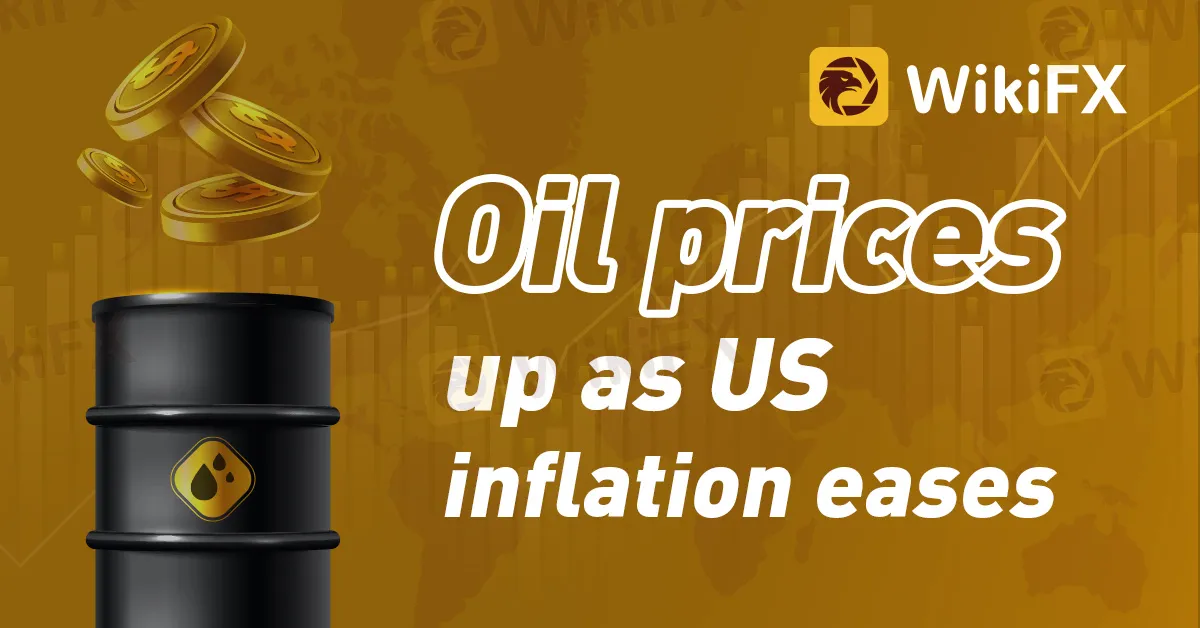简体中文
繁體中文
English
Pусский
日本語
ภาษาไทย
Tiếng Việt
Bahasa Indonesia
Español
हिन्दी
Filippiiniläinen
Français
Deutsch
Português
Türkçe
한국어
العربية
Oil prices up as US inflation eases
Abstract:According to Reuters, oil prices experienced a more than 1% increase on Thursday, reaching their highest point in nearly three months. This surge was driven by U.S. inflation data, which indicated that interest rates in the world's largest economy were nearing their peak.

According to Reuters, oil prices experienced a more than 1% increase on Thursday, reaching their highest point in nearly three months. This surge was driven by U.S. inflation data, which indicated that interest rates in the world's largest economy were nearing their peak.
Brent crude futures saw a rise of $1.25, equivalent to 1.6%, settling at $81.36 per barrel. The peak during the session reached $81.57, marking the highest level since April 25.
Similarly, U.S. West Texas Intermediate crude futures experienced a gain of $1.14, or 1.5%, reaching $76.89. The session's highest point was $77.13, the strongest level since April 26.
On Wednesday, data revealed that U.S. consumer prices had only moderately increased in June, with the smallest annual rise in over two years. This ongoing decline in inflation contributed to a drop in the U.S. dollar index, which fell to its lowest level since April 2022. The weakened dollar played a role in boosting oil prices, as it made crude more affordable for holders of other currencies.
Analysts like John Kilduff, a partner at Again Capital LLC in New York, attributed the increase in oil prices to the low inflation figures. Phil Flynn, an analyst at Price Futures Group, commented that fears of an interest rate hike by the Federal Reserve had previously acted as a headwind for oil prices. However, with the expectation of only one more rate rise, concerns eased. Higher interest rates have the potential to slow economic growth and reduce oil demand.
Recent rallies in oil prices, surpassing 11% over two weeks, were primarily driven by supply cuts from major producers Saudi Arabia and Russia, according to Craig Erlam, a senior market analyst at OANDA.
The structure of Brent futures contracts indicates a tightening market and suggests that OPEC's efforts to support the market may be succeeding. The premium of a front-month Brent contract compared to a six-month February 2024 contract rose to $2.64 per barrel on Wednesday. In late June, the front-month contract was at a discount compared to the six-month contract.
The International Energy Agency (IEA) released a report on Thursday predicting a record-high oil demand this year, although the increase would be slightly lower than previously anticipated due to broader economic challenges and interest rate hikes. Similarly, an OPEC report maintained an optimistic outlook on global oil demand despite economic weaknesses. It raised its growth forecast for 2023 and predicted a minor slowdown in 2024, with fuel consumption expected to be driven by China and India.
In China, however, the momentum of the post-pandemic recovery slowed, with exports contracting last month at the fastest pace since the onset of the pandemic three years ago, according to data from the country's Customs Bureau.

Disclaimer:
The views in this article only represent the author's personal views, and do not constitute investment advice on this platform. This platform does not guarantee the accuracy, completeness and timeliness of the information in the article, and will not be liable for any loss caused by the use of or reliance on the information in the article.
Read more

Gold Rate Today in Mumbai and Other Updates on Your Fingertips
After correcting for two straight days, gold rebounded on June 26, 2025, across 24 Karat and 22 Karat categories in Mumbai, the financial capital of India. Check out the latest price update.

CPI Inflation Eased to 2.82% in May 2025 - Check Out the Items Whose Prices Have Fallen
The Consumer Price Index (CPI) inflation dropped to a six-year low of 2.82% in May 2025, falling from 3.16% a month ago. Read this to know the extent of fall across food and non-food items.

Gold & Silver Prices Breach INR 1 Lakh in India - Check Out the Stunning Reasons
India’s bullion market is setting new records with both gold and silver prices breaching the INR 1-lakh mark in spot markets. Read this guide to know the factors that drive the bullion market crazy.

Soft Inflation, Firm Yields: Fed Rate Cut Delayed to Year-End
The U.S. bond market initially rallied on cooling inflation but lost steam as Wall Street bet on later rate cuts. Fed policy expectations now lean toward a December easing, dampening gold and boosting equities.
WikiFX Broker
Latest News
He Thought He Earned RM4 Million, But It Was All a Scam
CryptoCurrency Regulations in India 2025 – Key Things You Should Know
OctaFX Back in News: ED Attaches Assets Worth INR 134 Cr in Forex Scam Case
Trump inaugural impersonators scammed donors out of crypto, feds say
Ethereum is powering Wall Street's future. The crypto scene at Cannes shows how far it's come
Forex Hedging: Is It a Trader’s Safety Net or Just an Illusion?
US debt is now $37trn – should we be worried?
OPEC+ members agree larger-than-expected oil production hike in August
Top Wall Street analysts are pounding the table on these 3 stocks
US Jobs Data Out: Boom in Government Sector, Not So in Private Sector
Currency Calculator


